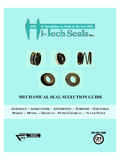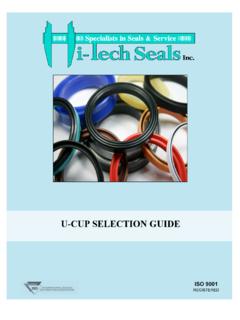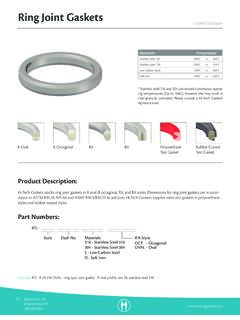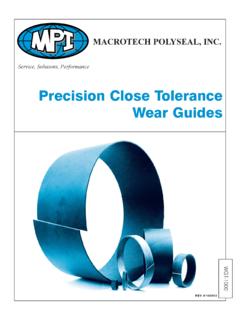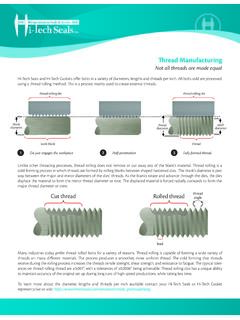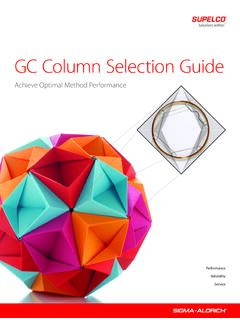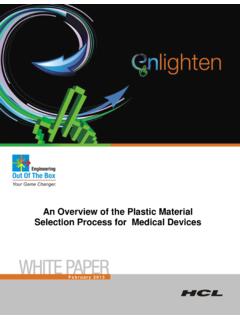Transcription of U-CUP SELECTION GUIDE
1 U-CUP SELECTION GUIDE . ISO 9001. REGISTERED. CONTENTS. Introduction 1. Seal SELECTION 2. Profiles 3. Part Numbering 4. Specifying A Seal 5. Gland Dimensions vs Seal Dimensions 6. Design Criteria 7. Design Criteria continued 8. Double Acting Applications 9. Replacing Existing Seals 10. The Z-Seal 11. Urethane U-Cups 12. Sealing Principles of the Z-Seal/Deep Z-Seal 13. HU Seals 14. Style 870 U-Cups 15. Installation Tools 16. Materials 17. Introduction The O-Ring Loaded U-CUP is a unique design that combines a precision molded "U" configuration packing with an elastomer loader. This seal was originally designed to improve the low pressure sealing capabilities of a standard lip type packing but the design principle has been effective in dealing with high and low temperature and pressure extremes, including vacuum.
2 While originally designed as a unidirectional sealing device, with the proper design and accessories, the O-Ring Loaded U-CUP can also be used as a bi-directional seal. The basic theory behind the O-Ring Loaded U-CUP is that when you add a "loader or energizer" to a lip seal, you turn it into a squeeze seal that provides high sealing force at low pressure. As the system pressure increases, the lip loading also increases, automatically compensating for the higher pressure while maintaining a positive seal. A rubber energizer typically has a better compression set, or memory than urethane and will enable the U-CUP to have a longer life expectancy. This brochure will take you through a variety of U-CUP related sealing products and materials while giving you some basic guidelines of sealing principles and theories to help you design for your unique needs.
3 1. Seal SELECTION There are a wide variety of U-CUP style seals for both rod and piston applications that come in an equally wide variety of materials. Below you will find the general guidelines you need to consider when choosing the style and material of the seal most appropriate for your application. For more demanding applications please contact your Hi-Tech Seals representative for design assistance. 1. Fluid Media - This will determine the type of seal materials and seal types suitable for your application. 2. Service Temperature - The minimum and maximum service temperatures of the seal and the fluid media will determine which materials and seal types are suitable. 3. Pressure and Clearance Gap - The maximum pressure and extrusion gap will determine the risk of seal extrusion failure in the application.
4 4. Leakage and Drift Expectation - Rod seal film control and piston seal drift varies between seal types. Refer to the Lip Squeeze Chart below for general guidelines. 5. Ancillary Performance Criteria - Friction: Does the application require a seal with a precise level of friction? Stability: At high linear velocities seal stability may be an issue. Stability varies between designs. Contamination: Many seal types are somewhat resistant to fluid contamination and solid particles. 6. Retrofit and Gland Size - Many seal types are available to fit the same gland size but not in all cases. 7. Assembly - Seal installation will vary depending on seal type and size. Care needs to be taken to ensure you will be able to install the seal style you choose. 8. Seal Life Expectancy - Performance will depend on several factors including duty cycle, stroke, speed, pressure, surface finish and fluid type.
5 Seal life will also vary depending on the style and material chosen. 9. Price and Availability - What suitable seal SELECTION will be the most cost effective for your application? Performance and Leakage Control Index LIP SQUEEZE CHART. LIP CONFIGURATION CHART. 2. Profiles O-Ring Loaded U-Cups are available in four common profiles: Standard Deep Type B. Square B. For each diameter there is also a variety of cross sections to choose from. Common cross sections are 1/8" - 1". The larger the cross section of the seal, the longer the life expectancy of the seal. The larger cross section seals are generally more reliable and more forgiving for design considerations such as tolerance, clearances, and surface finishes. Keep in mind that additional friction is created with a larger cross section seal and installation becomes more difficult.
6 The Standard O-Ring Loaded U-CUP profile is square in cross section and it is suitable for both rod and piston applications. The Standard design can be widely used to replace existing hydraulic packing and O-Rings without changing gland design. The Deep O-Ring Loaded U-CUP design is a modified version of the Standard's square shape. This design has approximately 1-1/2 times the axial depth of the Standard seal which greatly adds to the stability of the design in higher applications. Generally you would have to make gland modifications for this seal when replacing O-Rings but this design is ideal for replacing V or W packing or braided rope packing. The Type B O-Ring Loaded U-CUP is similar in design to the Deep but it features a back beveled sealing lip designed for additional film breaking ability and increased squeeze on the sealing surface.
7 By adding the back bevel on the lips, it aligns the seal interface near the centerline of the O-Ring energizer to provide increased sealing force which adds to the low pressure sealing capability while also increasing the high pressure sealing ability. The added length also provides stability to the seal. The Square B design provides you with the additional sealing ability of the back bevel lip design, while still being able to replace o-rings without changing the groove. 3. Part Numbering O-Ring Loaded U-Cups make use of a mnemonic part numbering system in that each series of numbers in the part number relate to a specific dimension in the sealing gland. There are four elements to this part number: 1. The first segment of the part number consists of three or four digits and represents the radial width of the seal in decimal equivalents (the decimal point is not used in this segment).
8 2. The second section of the part number is five digits (with decimal point) which specifies the inside diameter of the seal. 3. The third section of the part number consists of three - four digits (without decimal point) which identify the seals axial depth. For a Standard O-Ring Loaded U-CUP , where depth and width are the same, this series of numbers is deleted. 4. The fourth part of the numbering system identifies the specific seal design configuration required. The design configurations are identified as follows: The following are part number examples of the various O-Ring Loaded U-CUP design types which have the same inside and width values but differing depths. For the following, the seal is identified has a 4" ID and a 4-3/4" OD. In type SQB and Standard, the depth of the seal is 3/8".
9 In type B, Deep, and Z, the depth is 5/8". The numbering system does not change for different materials. For a complete list of machining dimensions, please visit our website at and view the Polyseal O-Ring Loaded U-CUP machining dimensions under the Tech Info/Reference tab. 4. Specifying a Seal 1. Select seal configuration. 2. Check seal material compatibility for temperature and fluid. 3. Select seal cross section size. 4. Use pre-engineered charts to determine seal part number, gland groove dimensions, tolerances, and metal machine surface finishes. 5. To determine dimensions for non-standard rod or bore diameters not shown in the charts, please contact Hi- Tech Seals. 6. Determine maximum extrusion gap from dimension and machining tolerances. Both tolerances and adjustments can be adjusted to accommodate maximum allowable extrusion gap.
10 7. Determine minimum mating fits from dimension and machining tolerances to assure ease of assembly. 5. Gland Dimensions vs Seal Dimensions Seal dimensions have traditionally been designed to accommodate standard gland widths and normal manufacturing tolerances. Reduction in radial gland width from that recommendation could result in excessive friction, heat and wear leading to premature failure of the seal. Similarly, increased radial gland width could allow the lips to pull away from the sealing surfaces and result in leakage. Three dimensions are necessary to completely define a seal gland: a diameter (either inside ( ID ) or outside ( OD ) diameter of the gland), the radial width of the gland and the axial depth. Typical seal and gland dimensions are shown below for both rod and piston applications.
